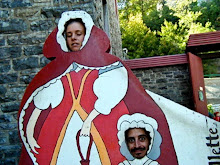
My motto, as it applies to photography, is: 'use your brain, not your wallet' (I wish these words applied across the board in my life, but that's not always the case.) I think I had spent my lifetime budget on photography by about 1997, mostly on darkroom supplies, and long before being exposed to the expenses of the digital realm. As I began to see the benefits of changing over to digital, I made a deal with myself that I would keep it creative and low budget, especially to remind myself that I was supposed to be in total control of the process. My first step was a cheap negative scanner, which allowed me to stop spending long hours in the darkroom getting fixer in my hair. I spent a lot of time playing with toy cameras, homemade pinholes, and making masks inside the camera while I traveled around. Such an enjoyable cure for boredom. I remember checking into a motel to develop a bunch of film on my way from New Orleans to Houston in a town called Sulfur; bad place to need to use a lot of water.
Holga photo 2003, Italy
Holga with a mask taped inside; I shot the bottom half of the film roll of lily pads while canoeing, and then rewound the film, flipped the mask over, and reshot the same roll. This time I exposed only the top half of the roll, shooting cow feeders at a dairy farm.
and a homemade pin-holga shot in Plymouth, Vermont
the shutter on a Holga is bound to fail sooner than later; I just made the broken cameras into pinholes that used remove-able velcro as a lens cap
But here we are today, in 2010, and I am finally and truly finished with developing film, as well. I even tried replacing developer with instant coffee for a time to try and break away from all those chemicals, and guess what - it smells totally putrid! Much worse than a dairy farm and a subway station on the hottest day of summer combined. I'm pretty happy with the digital world, but I like to keep my contributions to the process relevant, which can be challenging. In just about a week I'm headed to Florida to visit my family, and most of what we'll do there is take pictures. I know that keeping myself totally entertained on a lengthy birding trip with my dad means having a special photo technique at the ready (even if I'm not paying great attention to the birding part.) This year, I made sure to make a digital pinhole body cap before leaving. Body caps can be ordered online, and you can probably find a generic version at your local camera store, but don't expect that it will be cheaper.
first, you need to drill out a hole through the center of the body cap. I opted to hold the center to a flame, and then shoved a fondue fork through before it cooled. Sloppy, sloppy work, but much faster than setting up to drill.
next, I cut a small square of doubled tinfoil to place the pinhole in. First of all, aluminum foil is not the choicest material, but it's what I could find. When making the hole, place your hand over the top of the needle (you may want to wrap tape around the top so it's easier to hold in place) and spin the foil around in circles until you've broken through the tip. You're not trying to push the whole needle through.
Needles come in varying sizes, and I'm lying if I tell you that I understand this. I will tell you that no employee of a chain sewing store has ever been able to explain it to me, but regardless, the packages are clearly marked in the 'notions' aisle. I cannot even tell you for sure if the numbers go up or down according to diameter, I've read it both ways from so many sources (not just the internet.) It's like the time 2 different chiropractors told me to wear a lift in opposing shoes. The sewing world seems to say one thing and the photo world another. Could I get to the bottom of this? Sure, probably, but I know that small is what I'm going for. The whole concept is that the farther your 'film plane' (digital sensor) is from your pinhole, the larger the hole needed; digital slrs are thin in comparison to the wooden box pinhole cameras that are available. I think your best bet is to measure the needle diameter on a ruler, and record those measurements. The hole that you create is your aperture, and it is fixed. After creating this hole, you can only vary your results through the amount of available light and the length of your exposures. If the hole is too big, the focus of your photos will suffer, like so:
aperture (pin hole) too big in my aluminum foil - number 14 needle
You could determine an exact aperture for your pinhole after attaining the focal length and consulting a pinhole aperture chart. You'll also need a basic understanding of the corresponding needle size, but rest assured, what you're looking for is small. I need a pinhole of around .29 which as far as I can tell needs about a number 13 needle. The truth of the matter is that you mostly need patience to keep repeatedly testing and experimenting, and getting to know each altered body cap.
This time around I found my supply of copper sheeting (craft stores carry this) which holds the hole much better than aluminum foil. The colored pencil markings on the body cap are not actually marking center, but were helpful for me while I was melting the plastic.
I also glued a piece of black construction paper with a hole punched through it over the copper to help decrease any excess light pollution. Here's where I ended up:
apple
potatoes
clementines
I noticed some pros and cons right off the bat:
- obviously, it's great that you can see the image right away and make adjustments - that's tops.
- my xti has a Bulb mode (shutter stays open as long as you're pressing the button, which is an undeniable drag when you're on your 20th 3 minute exposure) but no Time mode ( push shutter once to start the exposure and again to end it.) Apparently, the remote control that Canon sells works as though in Time mode. On the plus side, Bulb mode has a digital clock to watch. If you taped something over the shutter to keep it depressed, you could just uncover and cover the pinhole when you're ready to expose. Velcro tabs, a book, etc...
- I can see flecks on the image where dust has gotten through the hole and fallen on the sensor. For $50 you can buy a manufactured pinhole bodycap that uses an opaque film over the hole to eliminate this problem.
- so much cheaper than a macro lens.
- vertical shots need a tripod, as most digital cameras don't have a flat side on either short end.
- again, holding the shutter down sucks - listen to music or the radio, and make sure that you're in a comfortable position. A minute is forever if you having nothing else to pay attention to.
The good news is that Florida is likely to be brighter, and my exposures will be shorter. I need a smaller needle to try a tighter aperture, as the focus still wasn't great. Also, I can't find an image to show you, but my favorite camera that I made had an irregular, rough hole and I loved it. I'd like to try to intentionally influence some different shapes for this one. I think that the spinning method keeps the pinhole cleaner, so maybe I'll go back to the quick, violent stab.




























